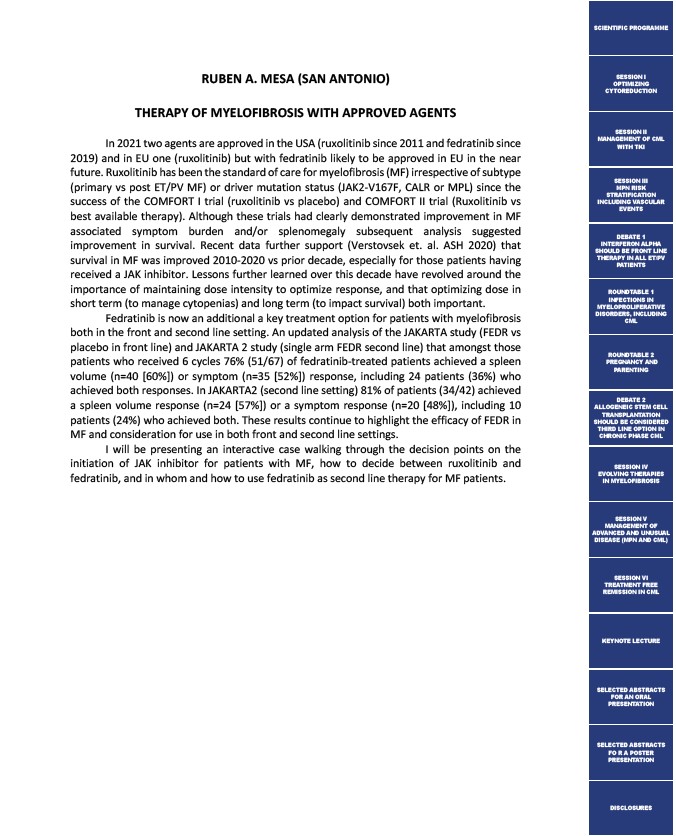
RUBEN A. MESA (SAN ANTONIO)
THERAPY OF MYELOFIBROSIS WITH APPROVED AGENTS
In 2021 two agents are approved in the USA (ruxolitinib since 2011 and fedratinib since
2019) and in EU one (ruxolitinib) but with fedratinib likely to be approved in EU in the near
future. Ruxolitinib has been the standard of care for myelofibrosis (MF) irrespective of subtype
(primary vs post ET/PV MF) or driver mutation status (JAK2-V167F, CALR or MPL) since the
success of the COMFORT I trial (ruxolitinib vs placebo) and COMFORT II trial (Ruxolitinib vs
best available therapy). Although these trials had clearly demonstrated improvement in MF
associated symptom burden and/or splenomegaly subsequent analysis suggested
improvement in survival. Recent data further support (Verstovsek et. al. ASH 2020) that
survival in MF was improved 2010-2020 vs prior decade, especially for those patients having
received a JAK inhibitor. Lessons further learned over this decade have revolved around the
importance of maintaining dose intensity to optimize response, and that optimizing dose in
short term (to manage cytopenias) and long term (to impact survival) both important.
Fedratinib is now an additional a key treatment option for patients with myelofibrosis
both in the front and second line setting. An updated analysis of the JAKARTA study (FEDR vs
placebo in front line) and JAKARTA 2 study (single arm FEDR second line) that amongst those
patients who received 6 cycles 76% (51/67) of fedratinib-treated patients achieved a spleen
volume (n=40 60%) or symptom (n=35 52%) response, including 24 patients (36%) who
achieved both responses. In JAKARTA2 (second line setting) 81% of patients (34/42) achieved
a spleen volume response (n=24 57%) or a symptom response (n=20 48%), including 10
patients (24%) who achieved both. These results continue to highlight the efficacy of FEDR in
MF and consideration for use in both front and second line settings.
I will be presenting an interactive case walking through the decision points on the
initiation of JAK inhibitor for patients with MF, how to decide between ruxolitinib and
fedratinib, and in whom and how to use fedratinib as second line therapy for MF patients.
SCIENTIFIC PROGRAMME
SESSION I
OPTIMIZING
CYTOREDUCTION
SESSION II
MANAGEMENT OF CML
WITH TKI
SESSION III
MPN RISK
STRATIFICATION
INCLUDING VASCULAR
EVENTS
DEBATE 1
INTERFERON ALPHA
SHOULD BE FRONT LINE
THERAPY IN ALL ET/PV
PATIENTS
ROUNDTABLE 1
INFECTIONS IN
MYELOPROLIFERATIVE
DISORDERS, INCLUDING
CML
ROUNDTABLE 2
PREGNANCY AND
PARENTING
DEBATE 2
ALLOGENEIC STEM CELL
TRANSPLANTATION
SHOULD BE CONSIDERED
THIRD LINE OPTION IN
CHRONIC PHASE CML
SESSION IV
EVOLVING THERAPIES
IN MYELOFIBROSIS
SESSION V
MANAGEMENT OF
ADVANCED AND UNUSUAL
DISEASE (MPN AND CML)
SESSION VI
TREATMENT FREE
REMISSION IN CML
KEYNOTE LECTURE
SELECTED ABSTRACTS
FOR AN ORAL
PRESENTATION
SELECTED ABSTRACTS
FO R A POSTER
PRESENTATION
DISCLOSURES